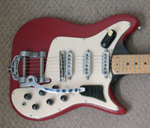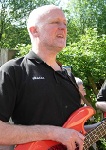Guitarists don't move down to bass, we move up!
I agree that bass players should play the bass. You want to play lead? Sell it and buy another instrument!
Jet and Licorice chatting
Moderators: David Martin, dave robinson, Iain Purdon, George Geddes
18 posts
• Page 2 of 2 • 1, 2
-

Uncle Fiesta - Posts: 1188
- Joined: Fri Apr 27, 2012 11:31 pm
- Location: near Gainsborough, England
- Full Real Name: Steve Tebble
Re: Jet and Licorice chatting
Moderne wrote:I'd never heard that about the Fender VI not being audible in certain parts of the audience before.
There was, quite simply, a lack of powerful amplification at the time. The AC30 barely makes 30 watts with its 4xEL84 in cathode bias mode and, while an open-backed speaker cab may be OK for lead and rhythm guitar where there is very little fundamental from the low E string, a six-string bass starting at 40Hz needs some guts in the amplifier to develop the sound.
JMI's design team were tied up around 1962 in developing the Continental Organ and transistor amp designs, so they badged the 2xEL34 design by Triumph Electronics as the AC50. This still had cathode bias, so was really a 40-45 watt amp. However it had big transformers and was paired with a cab with upgraded Celestions and a treble horn which gave it more of a kick. The T.60 bass cab was used for bass guitar. These were the amps that the Beatles took to the USA in 1963 and 1964 but it was all too late for Jet at the time of Besame Mucho and The Man With The Golden Arm.
In 1964, Vox produced the AC100 from the AC50 with 4xEL34, in the same way that the AC15 with 2xEL84 became the AC30 with 4xEL84. However, it still had cathode bias so the realistic output was only about 75-80 watts. It took Jim Marshall to produce a true 100watts from 4xEL34 when he used fixed bias, following the lead of Leo Fender's amps.
Ray
-

RayL - Posts: 1260
- Joined: Wed Sep 16, 2009 4:25 pm
- Location: Carshalton, Surrey
- Full Real Name: Ray Liffen
Re: Jet and Licorice chatting
Uncle Fiesta wrote:Guitarists don't move down to bass, we move up!
I agree that bass players should play the bass. You want to play lead? Sell it and buy another instrument!
I personally don't entirely agree. As I remarked above, I think it depends on the type of music one plays.
- iefje
- Posts: 1808
- Joined: Fri Sep 18, 2009 4:00 pm
- Full Real Name: Ivo Koers
Re: Jet and Licorice chatting
To me, the expressions 'moving up to lead' or 'moving down to bass' imply that playing lead guitar is more difficult and a bigger achievement than playing bass. I think it depends on what you play. One can play easy or more difficult lead guitar and easy or more difficult bass guitar as well. The lead guitarist in our band plays quite advanced blues/rock lead guitar and sometimes practices on bass guitar as well. He once told me that it's not that easy to play bass guitar. It's a different mindset.
- iefje
- Posts: 1808
- Joined: Fri Sep 18, 2009 4:00 pm
- Full Real Name: Ivo Koers
Re: Jet and Licorice chatting
It is certainly a different mindset.
When I said MG moved down, I did not mean demotion, just lower notes!
When I said MG moved down, I did not mean demotion, just lower notes!
Iain Purdon
site admin group
site admin group
-

Iain Purdon - Site Admin
- Posts: 3334
- Joined: Sat Sep 12, 2009 3:21 pm
- Location: Axmouth, Devon
- Full Real Name: Iain Purdon
Re: Jet and Licorice chatting
Or a lower number of strings!
-

Uncle Fiesta - Posts: 1188
- Joined: Fri Apr 27, 2012 11:31 pm
- Location: near Gainsborough, England
- Full Real Name: Steve Tebble
Re: Jet and Licorice chatting
Uncle Fiesta wrote:Or a lower number of strings!
Not necessarily. Watch the "At Their Very Best" gig in LIverpool 1989. Griff is playing a 6-string bass!!
Iain Purdon
site admin group
site admin group
-

Iain Purdon - Site Admin
- Posts: 3334
- Joined: Sat Sep 12, 2009 3:21 pm
- Location: Axmouth, Devon
- Full Real Name: Iain Purdon
Re: Jet and Licorice chatting
RayL wrote:Moderne wrote:I'd never heard that about the Fender VI not being audible in certain parts of the audience before.
There was, quite simply, a lack of powerful amplification at the time. The AC30 barely makes 30 watts with its 4xEL84 in cathode bias mode and, while an open-backed speaker cab may be OK for lead and rhythm guitar where there is very little fundamental from the low E string, a six-string bass starting at 40Hz needs some guts in the amplifier to develop the sound.
JMI's design team were tied up around 1962 in developing the Continental Organ and transistor amp designs, so they badged the 2xEL34 design by Triumph Electronics as the AC50. This still had cathode bias, so was really a 40-45 watt amp. However it had big transformers and was paired with a cab with upgraded Celestions and a treble horn which gave it more of a kick. The T.60 bass cab was used for bass guitar. These were the amps that the Beatles took to the USA in 1963 and 1964 but it was all too late for Jet at the time of Besame Mucho and The Man With The Golden Arm.
In 1964, Vox produced the AC100 from the AC50 with 4xEL34, in the same way that the AC15 with 2xEL84 became the AC30 with 4xEL84. However, it still had cathode bias so the realistic output was only about 75-80 watts. It took Jim Marshall to produce a true 100watts from 4xEL34 when he used fixed bias, following the lead of Leo Fender's amps.
Ray
Thanks for explaining that, Ray.
- Moderne
- Posts: 739
- Joined: Fri Sep 18, 2009 6:00 pm
- Full Real Name: Clive Webb
18 posts
• Page 2 of 2 • 1, 2
Who is online
Users browsing this forum: Majestic-12 [Bot] and 22 guests
These advertisements are selected and placed by Google to assist with the cost of site maintenance.
ShadowMusic is not responsible for the content of external advertisements.



